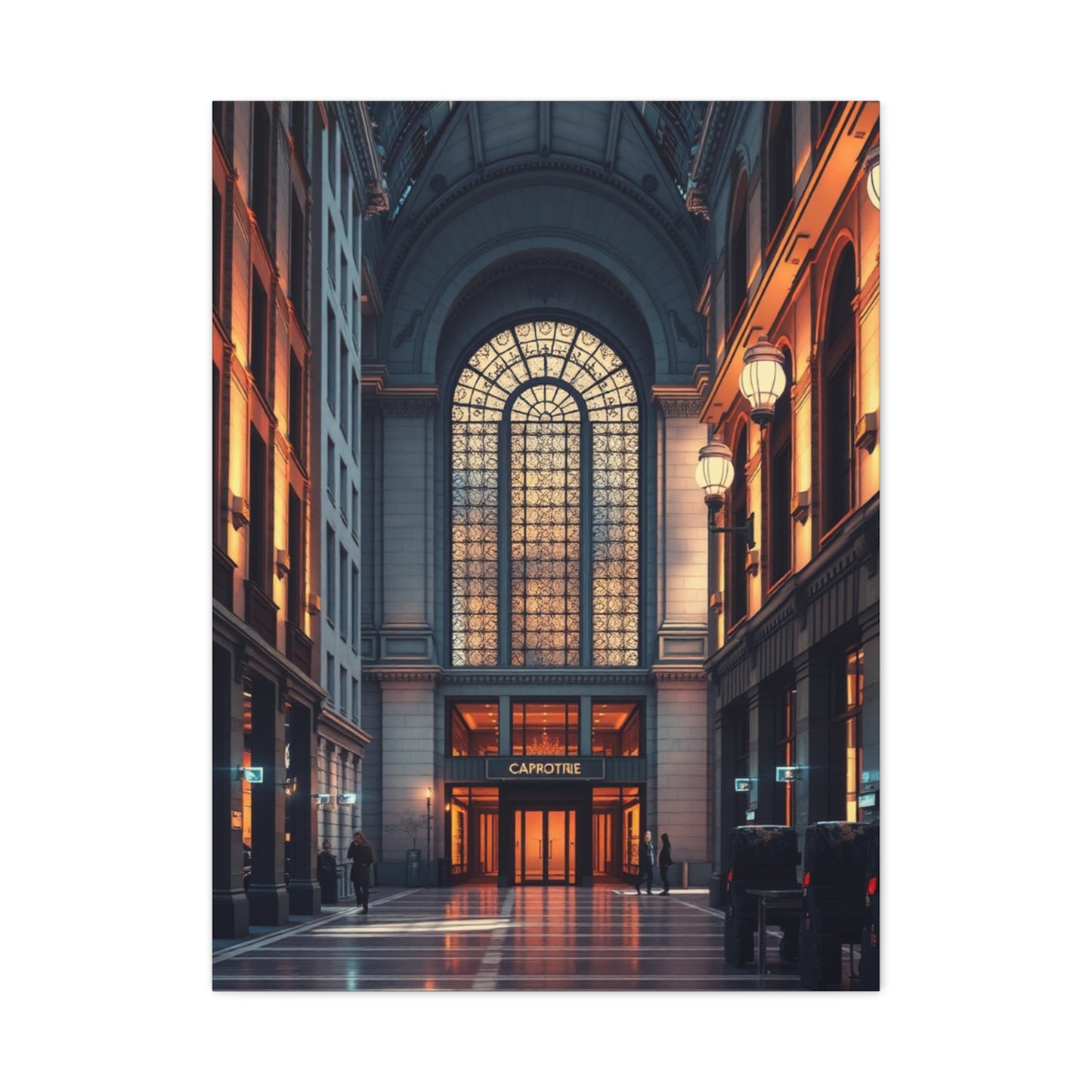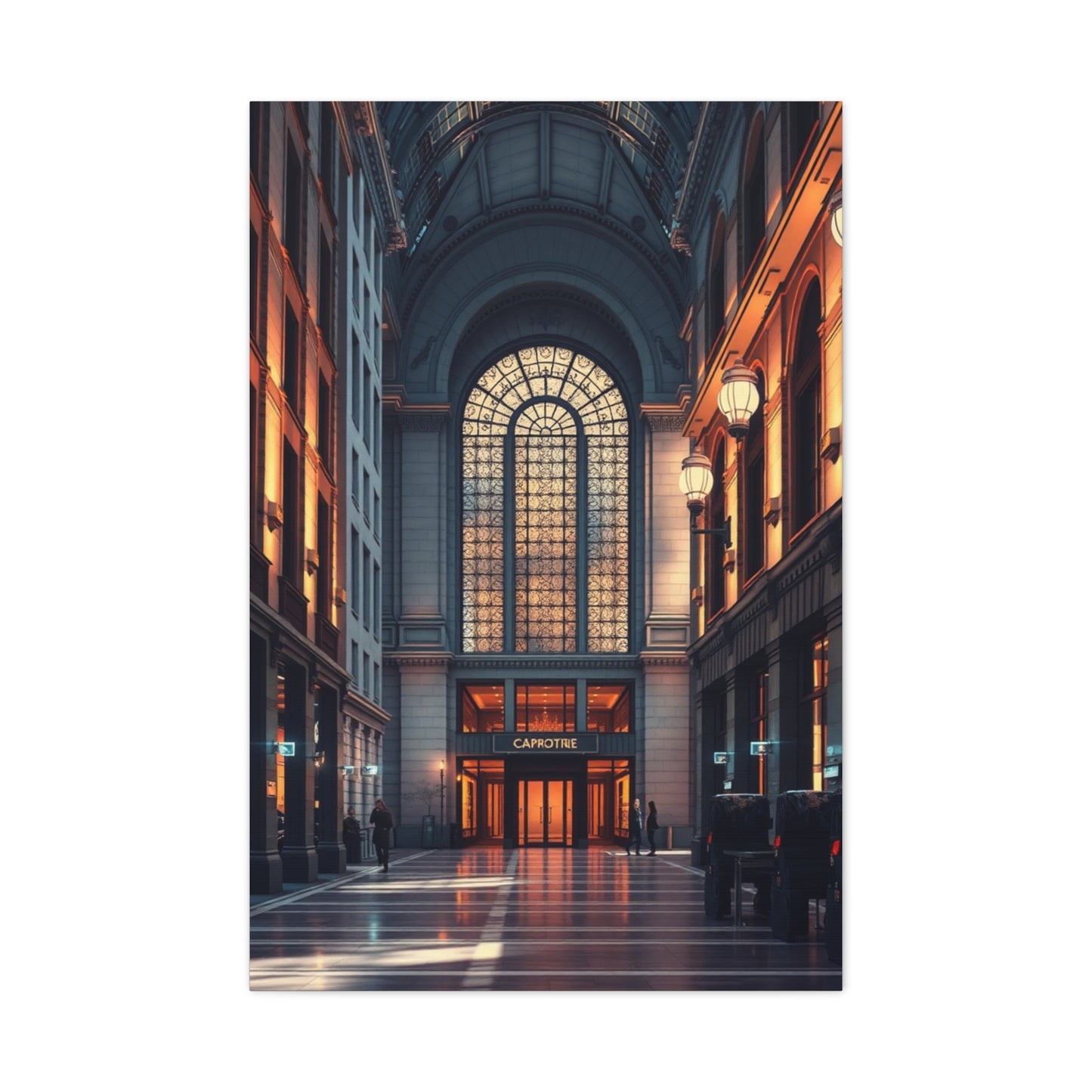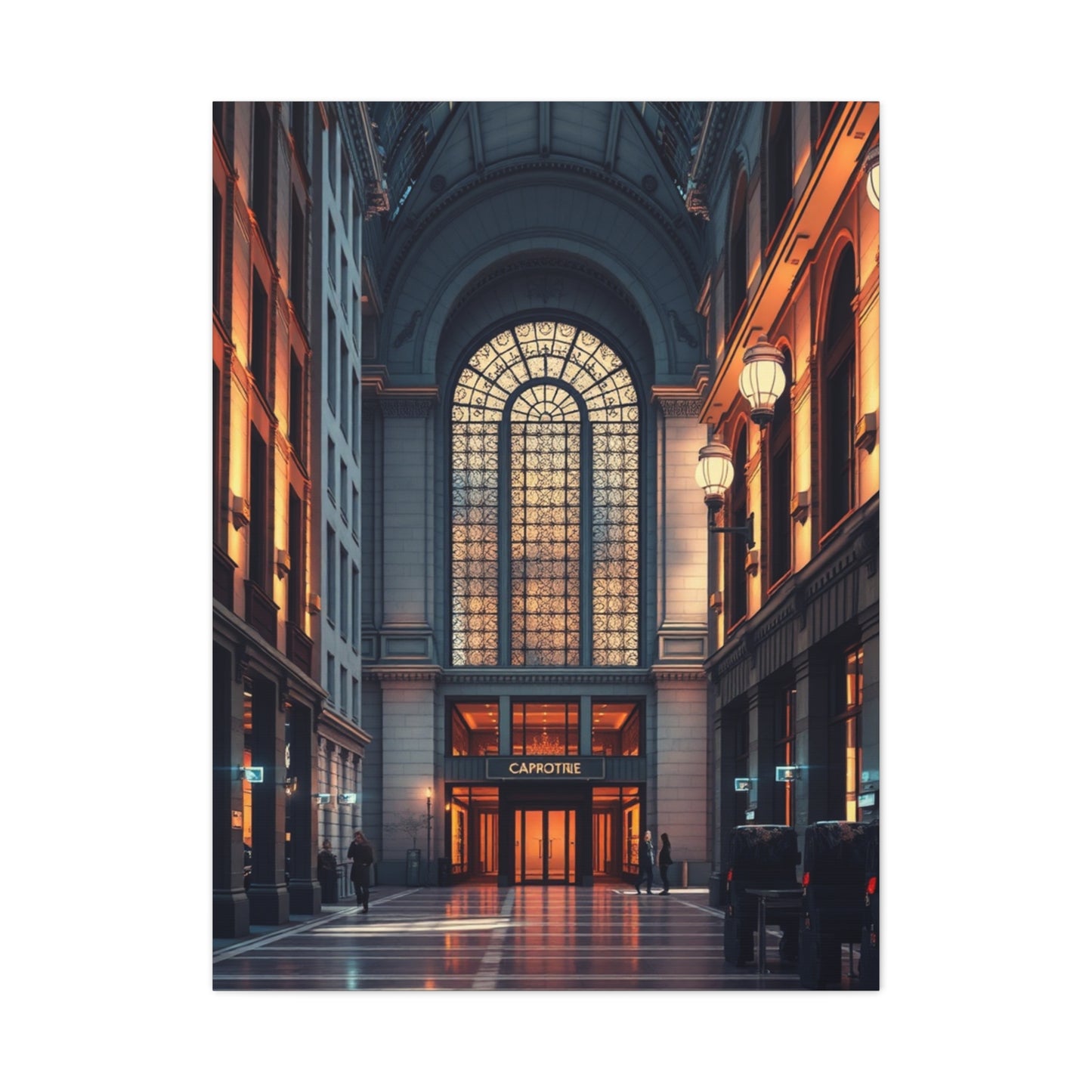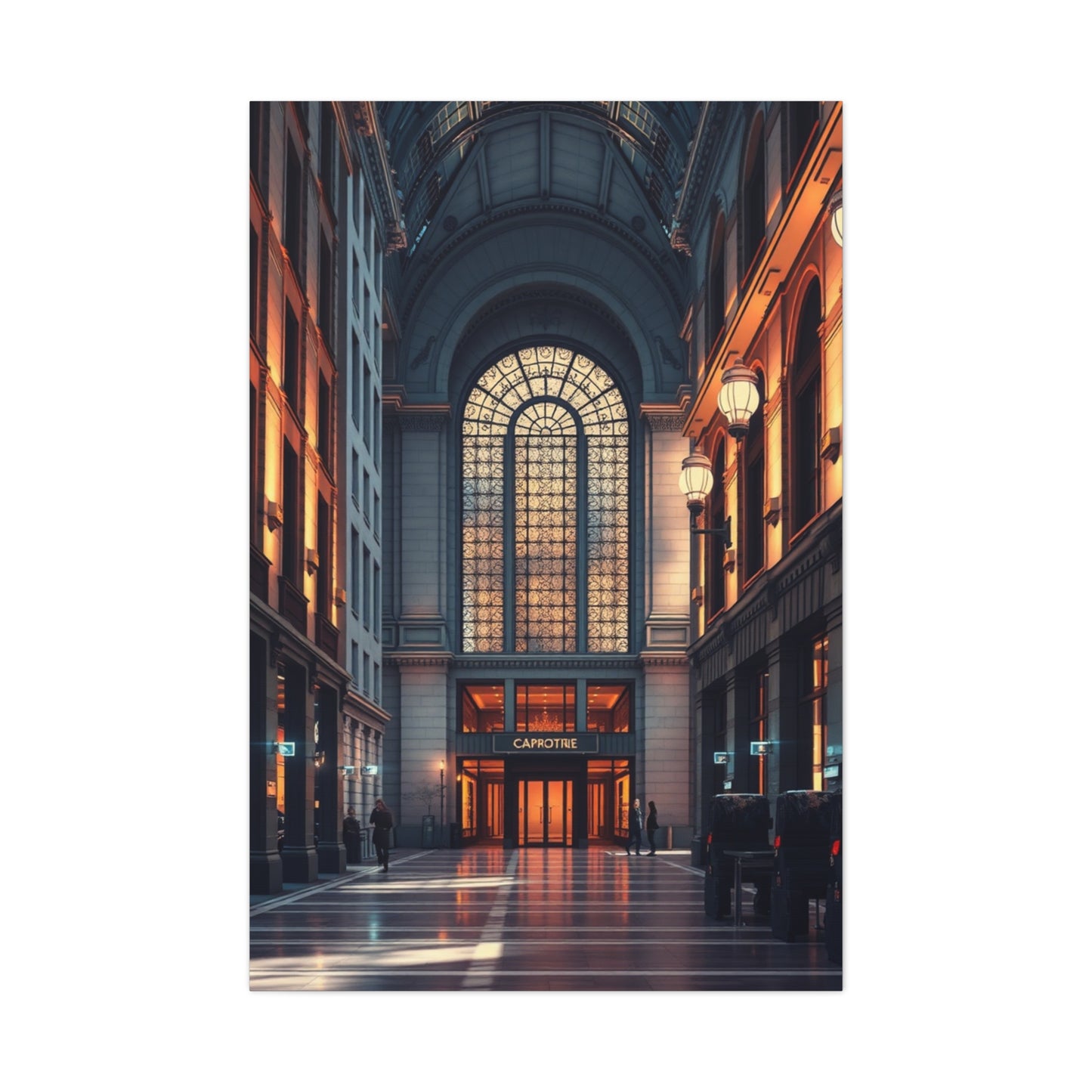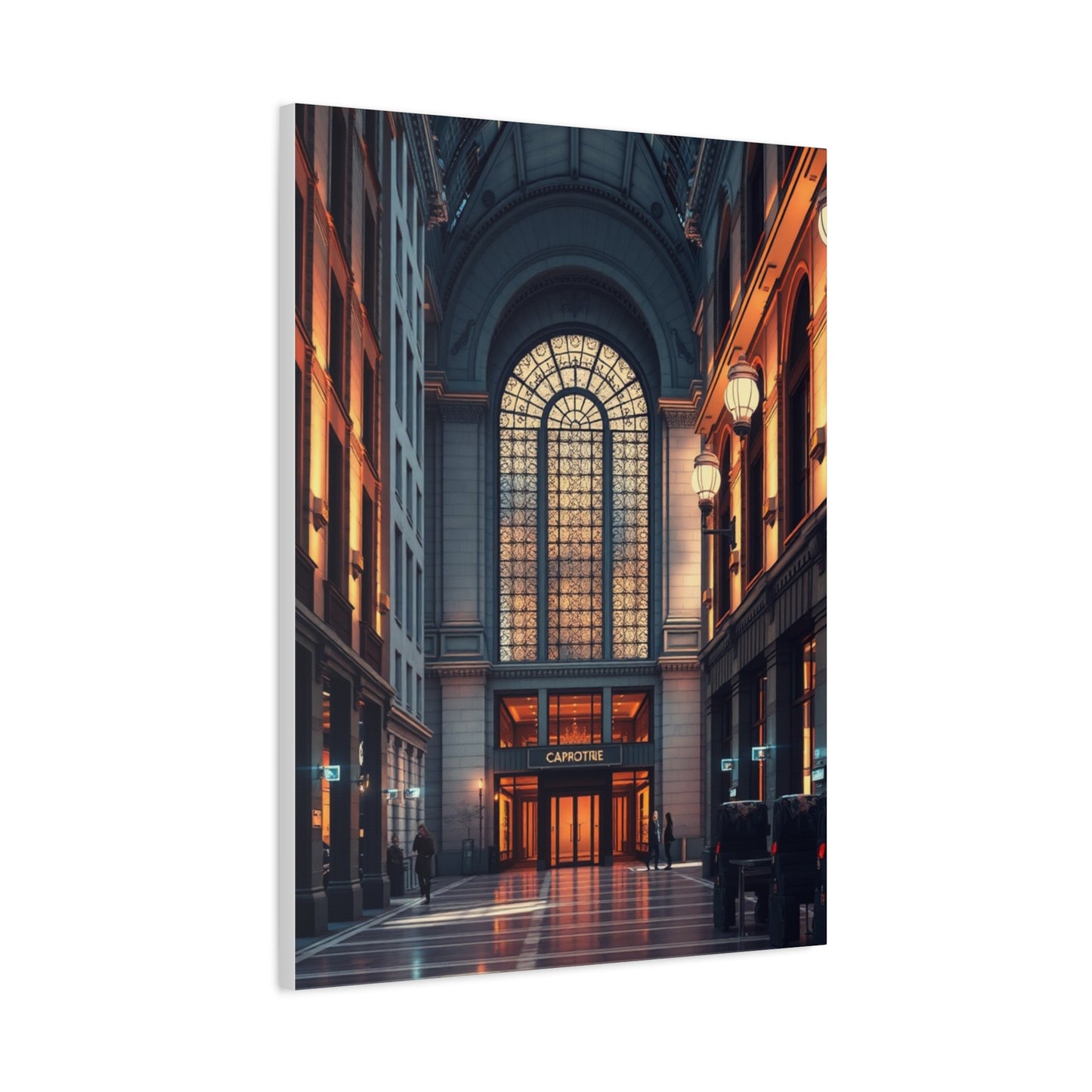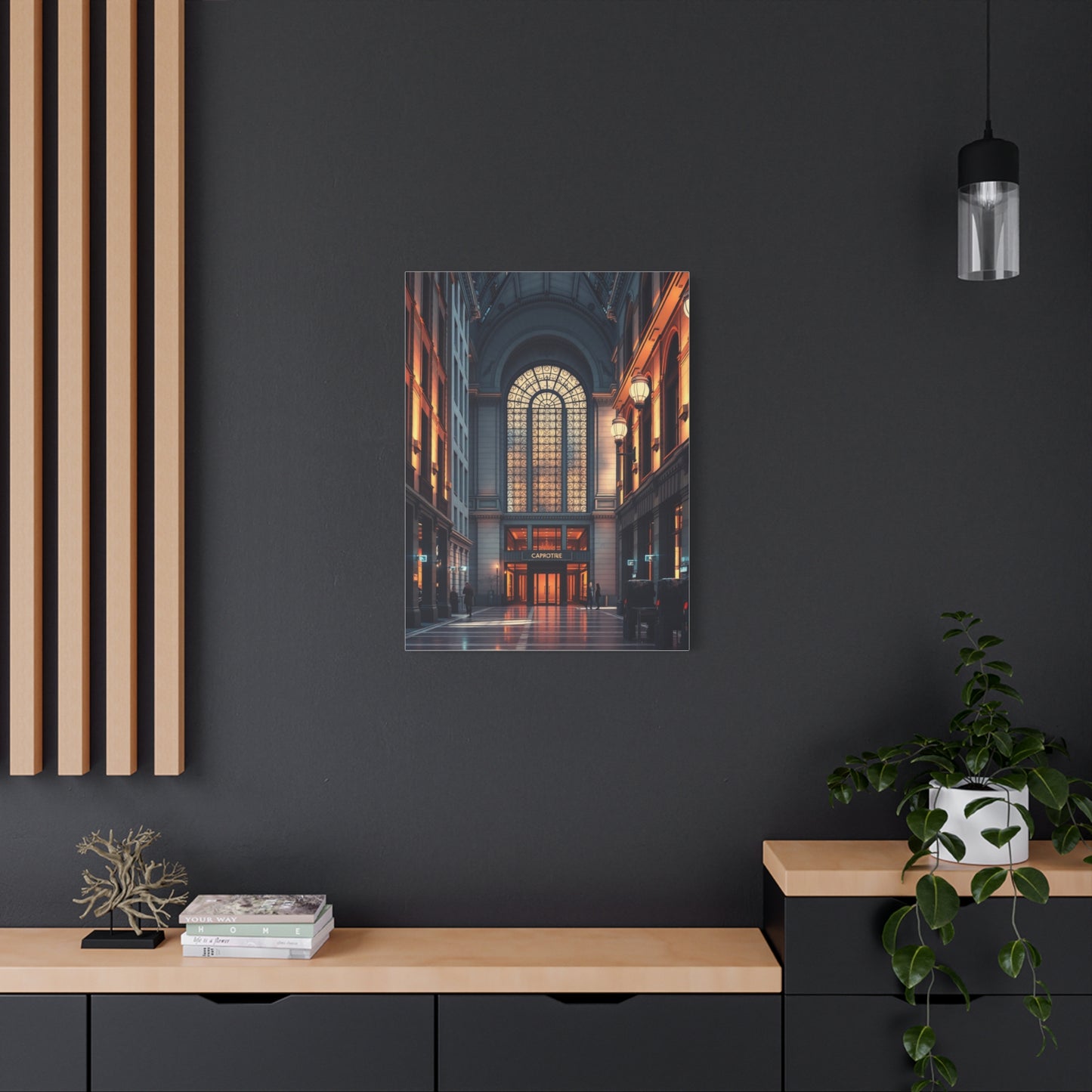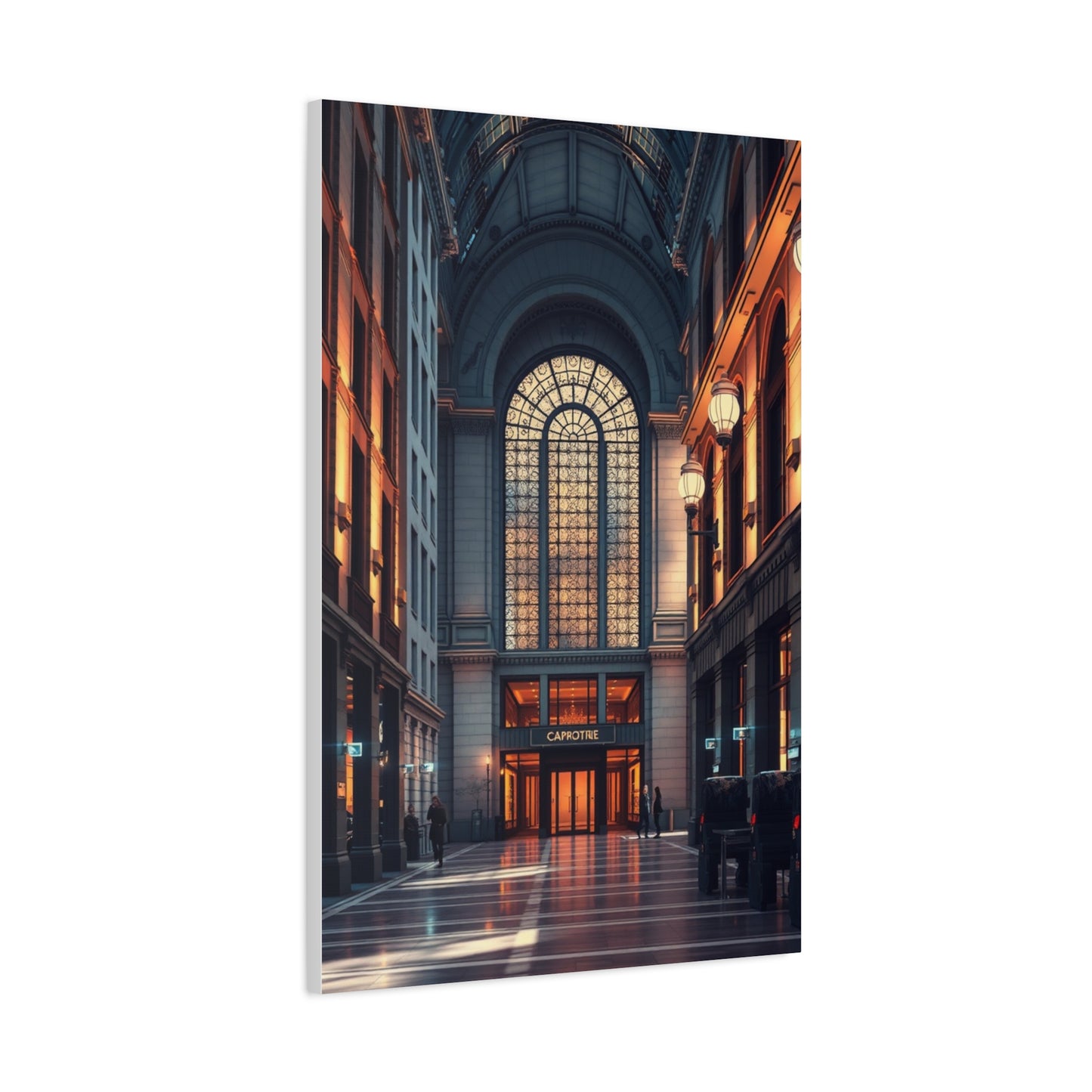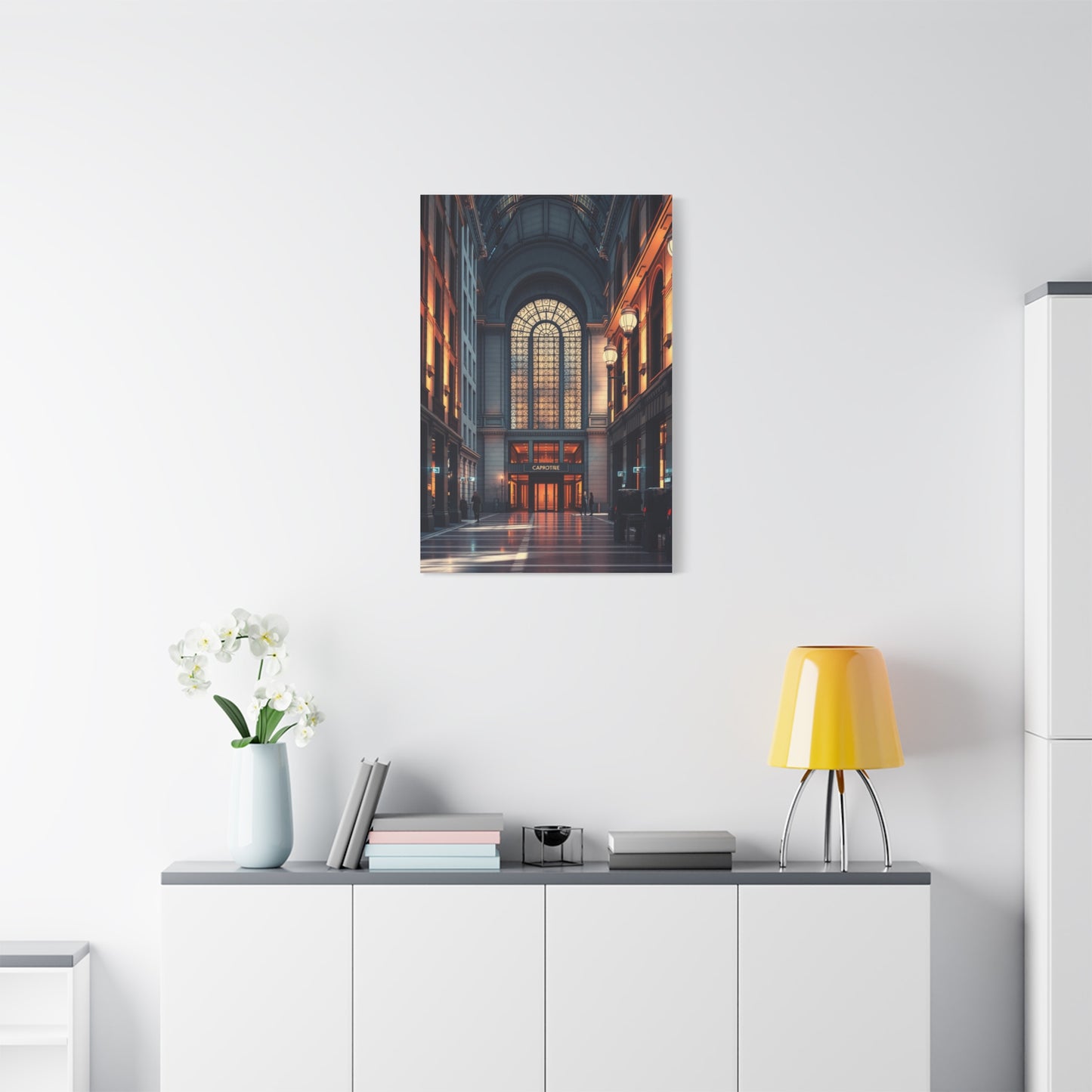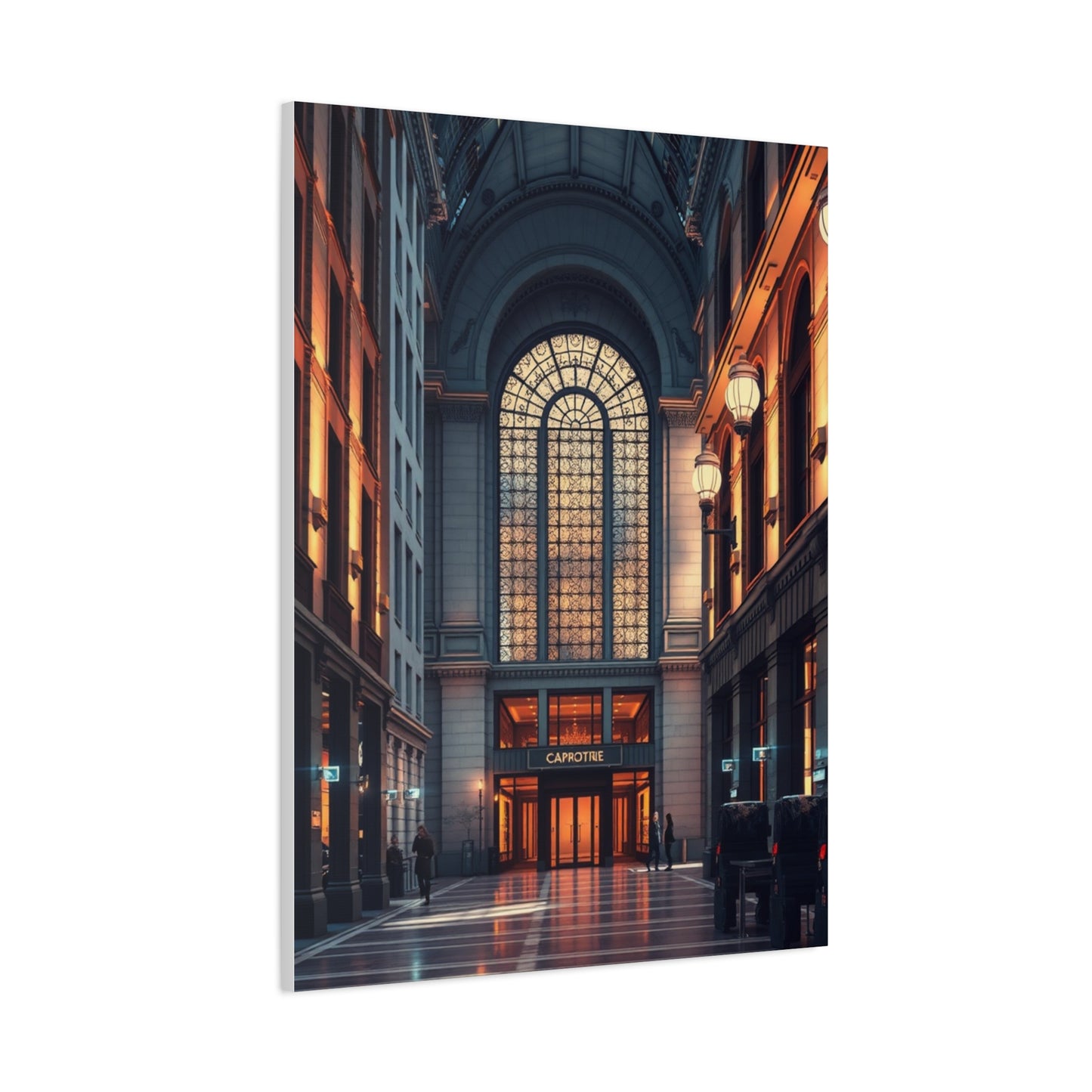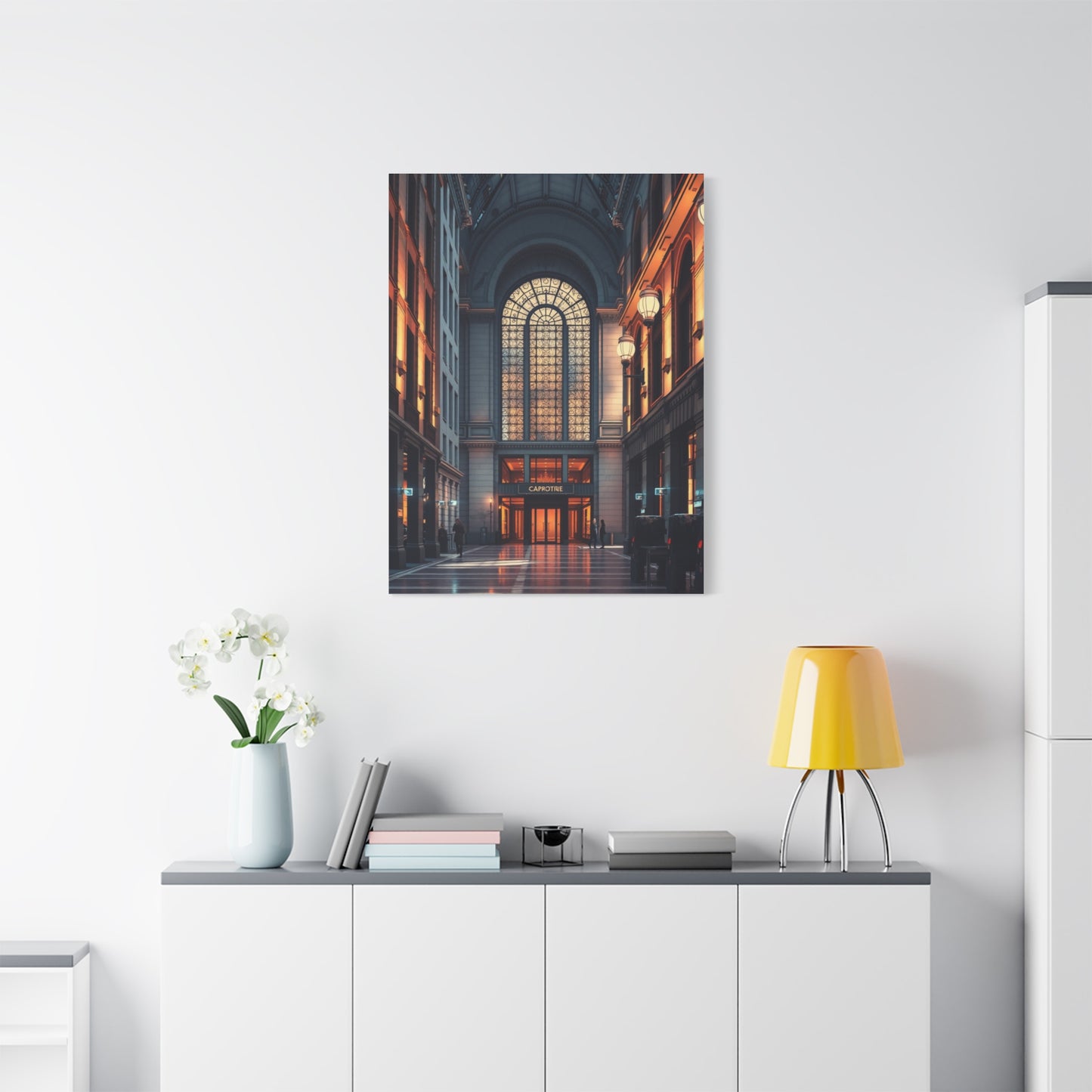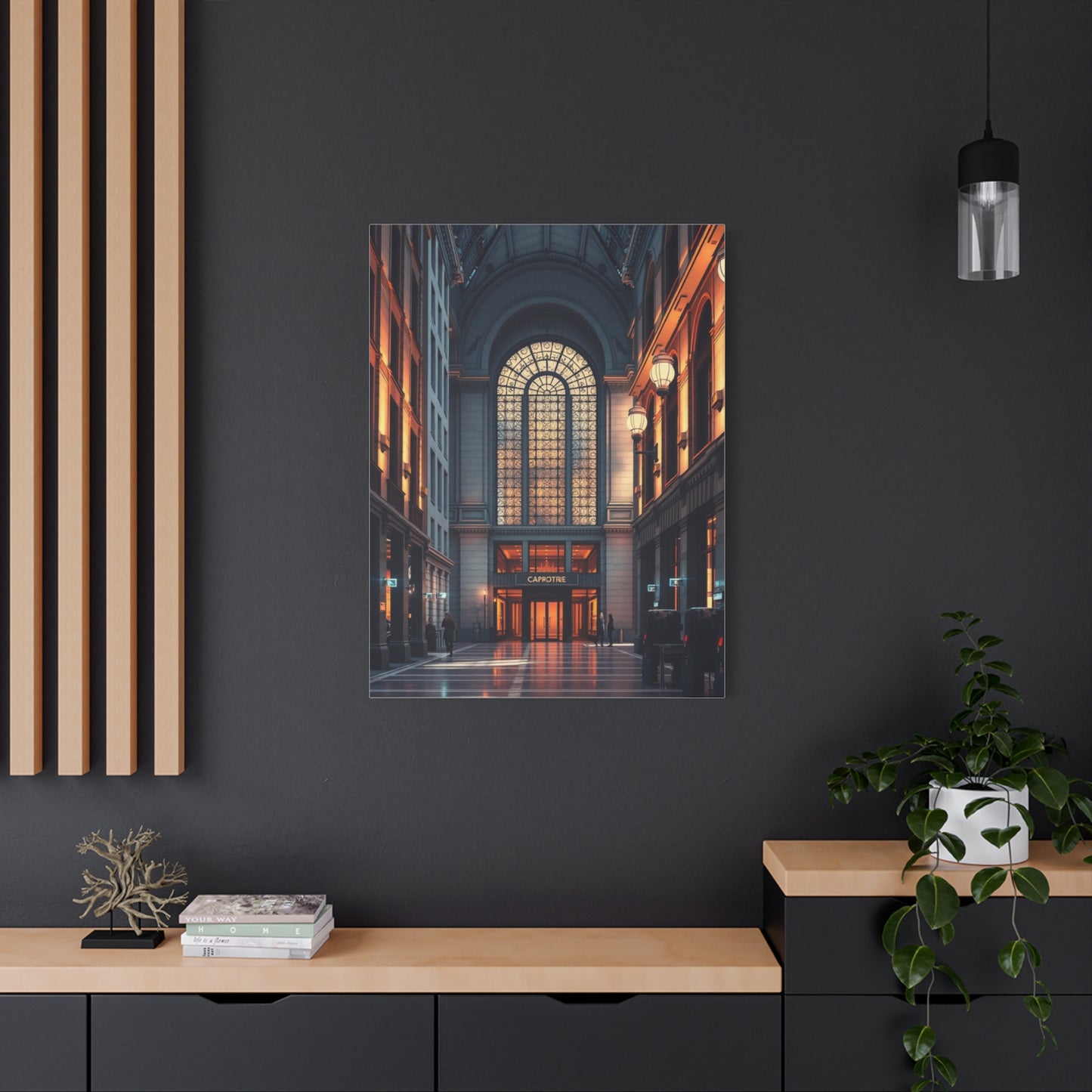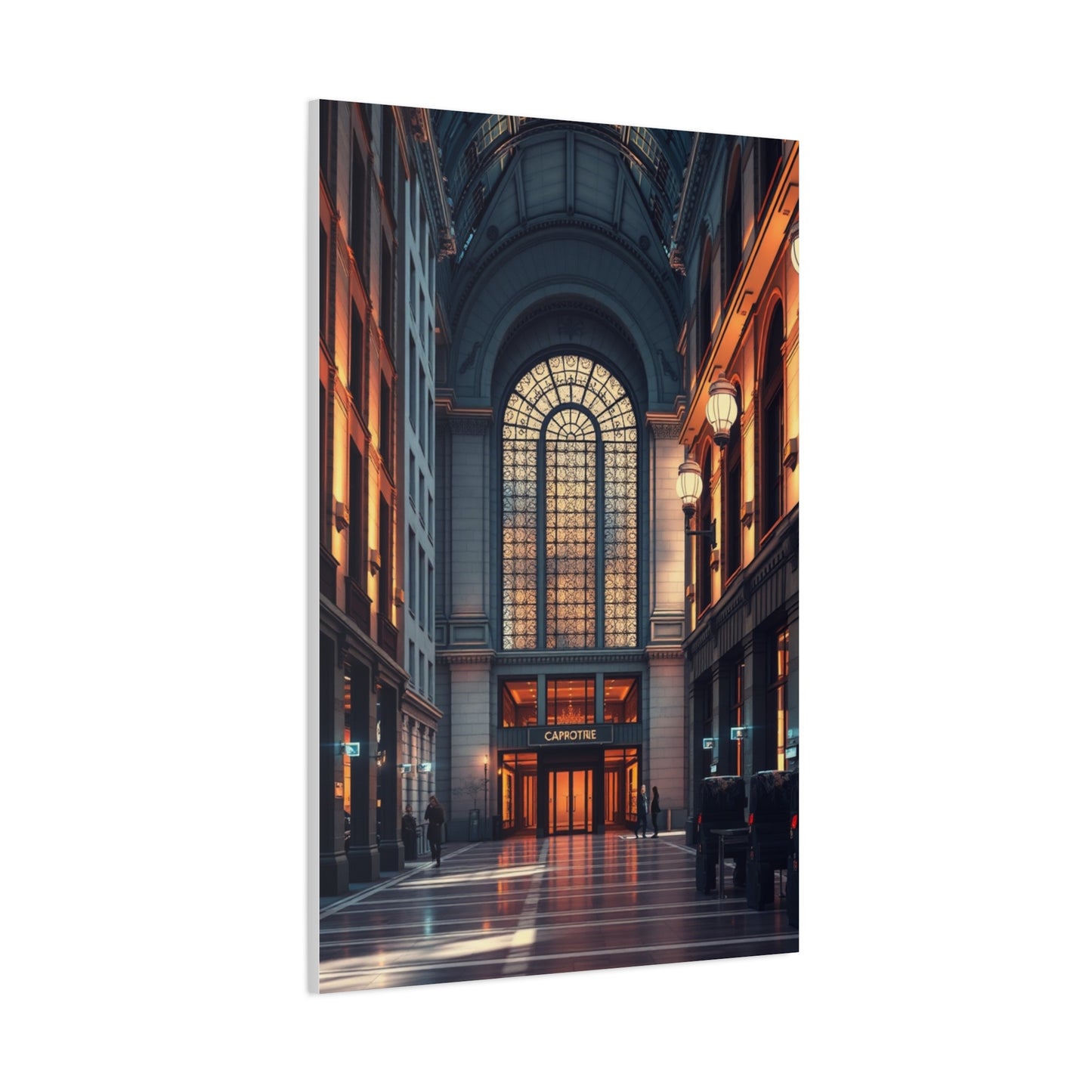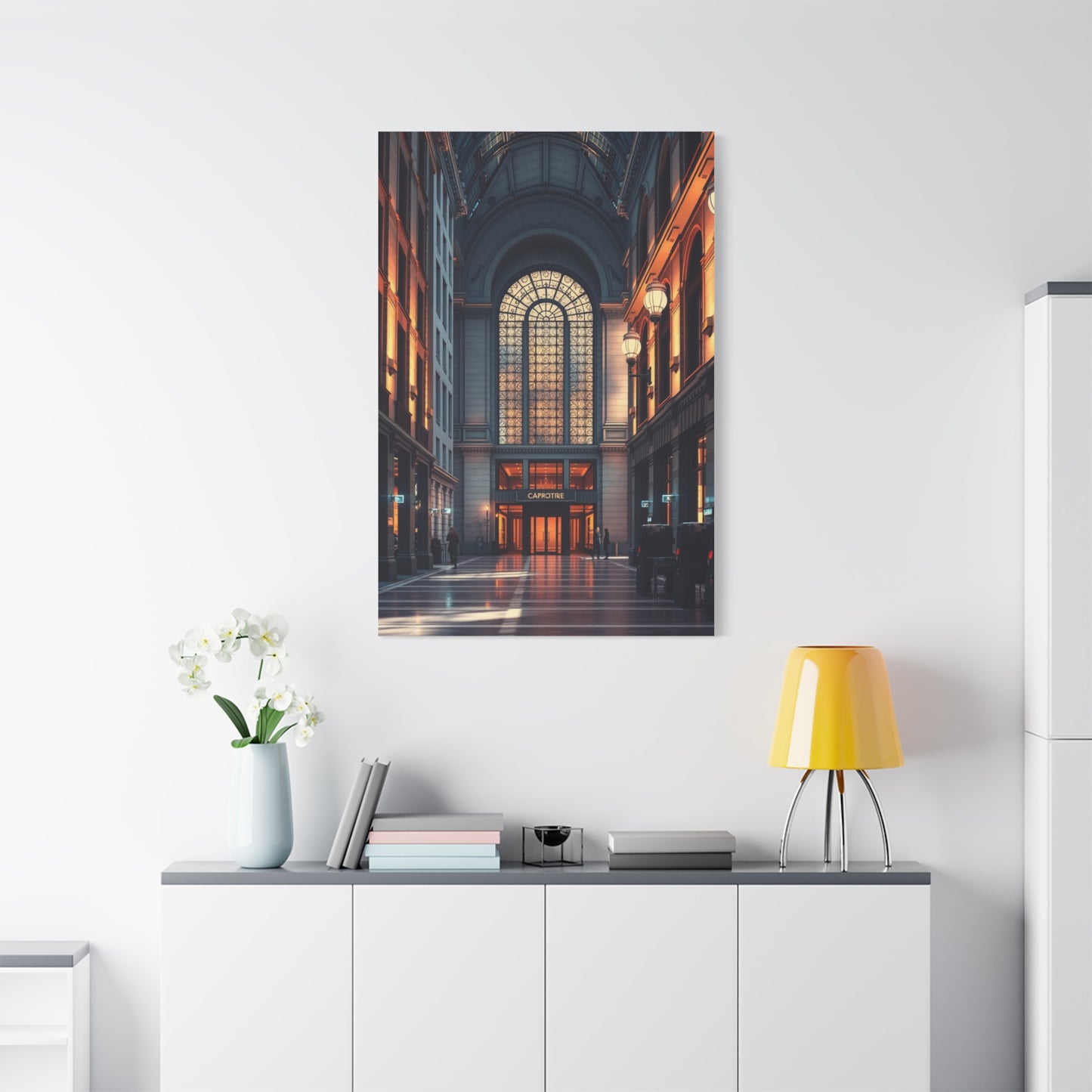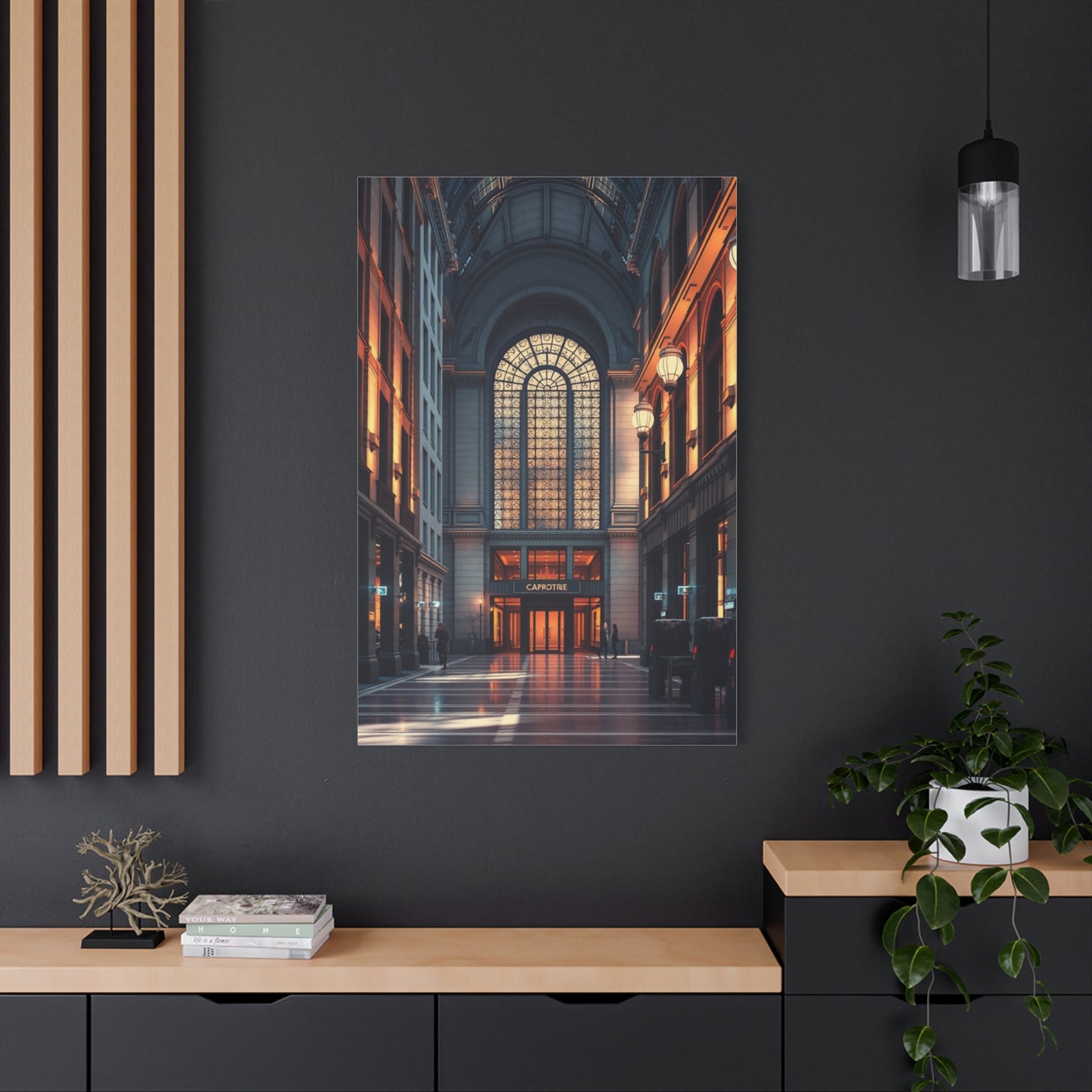Architectural Symphony Canvas Wall Art: Elevating Interior Spaces Through Structural Beauty
Architectural symphony canvas wall art represents a magnificent fusion of structural elegance and artistic expression that has captivated interior design enthusiasts around the world. This specialized form of decorative artwork captures the essence of iconic buildings, modern constructions, historical landmarks, and abstract architectural elements through high-quality canvas print techniques. The growing popularity of architectural symphony canvas wall art stems from its ability to transform ordinary living spaces into sophisticated environments that reflect personal taste and cultural appreciation.
The concept behind architectural symphony canvas wall art goes beyond simple decoration. Each piece tells a story of human achievement, engineering prowess, and creative vision. Whether featuring the sweeping curves of contemporary skyscrapers, the ornate details of classical buildings, or the minimalist lines of modern design, these canvas prints serve as windows into different architectural movements and periods. The term symphony itself suggests a harmonious composition where different elements work together to create a cohesive and impactful visual experience.
When selecting architectural symphony canvas wall art for your home or office, you enter a world where structure meets aesthetics. These pieces appeal to professionals in the construction industry, architecture students, design enthusiasts, and anyone who appreciates the built environment. The versatility of architectural symphony canvas wall art allows it to complement various interior design styles, from industrial lofts with exposed brick walls to minimalist apartments with clean lines and neutral palettes.
The production quality of architectural symphony canvas wall art has reached remarkable heights in recent years. Advanced printing technologies ensure that every detail of the original architectural photograph or illustration is faithfully reproduced on premium canvas material. The texture of the canvas adds depth and dimension to the artwork, creating a museum-quality appearance that flat prints cannot achieve. Many pieces feature gallery-wrap construction, where the image extends around the edges of the frame, eliminating the need for additional framing and creating a contemporary, finished look.
Collectors and decorators choose architectural symphony canvas wall art for multiple reasons. The timeless nature of architectural subjects means these pieces rarely go out of style, making them excellent long-term investments for interior decoration. Unlike trendy artwork that may lose appeal over time, well-executed architectural prints maintain their relevance and visual interest for years. Additionally, these pieces serve as conversation starters, inviting guests to discuss their own travel experiences, architectural preferences, or appreciation for specific building styles.
Architectural Art in Canvas Printing
The journey of architectural representation in art extends back centuries, long before the invention of canvas printing technology. Ancient civilizations documented their architectural achievements through various mediums, including frescoes, mosaics, and carved reliefs. The Romans, Greeks, and Egyptians all left detailed artistic records of their building accomplishments, recognizing the importance of preserving architectural legacy through visual representation. These early forms of architectural art laid the groundwork for the appreciation of structural beauty that continues today.
During the Renaissance period, architectural drawing and painting reached new levels of sophistication. Artists like Leonardo da Vinci and Michelangelo created detailed architectural sketches that served both practical and aesthetic purposes. The development of perspective drawing techniques allowed artists to represent three-dimensional structures on two-dimensional surfaces with unprecedented accuracy. These Renaissance innovations established conventions for architectural representation that still influence how we capture and display buildings in art today.
The invention of photography in the 19th century revolutionized architectural documentation. Photographers could now capture exact likenesses of buildings, preserving details that manual drawing might miss or idealize. Early architectural photographers faced significant technical challenges, including long exposure times and cumbersome equipment, but they persevered to create stunning images of cathedrals, bridges, monuments, and urban landscapes. These photographs became valuable historical records and works of art in their own right.
Canvas printing technology emerged as photographic reproduction methods advanced throughout the 20th century. Initially, transferring photographic images onto canvas required complex processes involving chemical treatments and manual application. As digital technology developed, the process became more accessible and affordable. Digital printing allowed for precise color reproduction, fine detail preservation, and consistent quality across multiple copies. This democratization of canvas printing made high-quality architectural art available to a broader audience beyond wealthy collectors and institutions.
Types and Styles of Architectural Symphony Canvas Wall Art
The world of architectural symphony canvas wall art encompasses numerous styles, each offering unique aesthetic qualities and emotional resonances. Modern architectural canvas prints typically feature clean lines, geometric shapes, and minimalist compositions that highlight contemporary design principles. These pieces often showcase glass-and-steel skyscrapers, innovative residential designs, or abstract interpretations of modern structures. The color palettes tend toward neutrals, with strategic pops of color that draw the eye to specific architectural features. Modern architectural canvas prints work particularly well in contemporary interiors where simplicity and functionality take precedence.
Classical architectural canvas wall art transports viewers to different historical periods through representations of ancient temples, medieval cathedrals, Renaissance palaces, and neoclassical buildings. These pieces celebrate ornamental details, symmetrical proportions, and the craftsmanship of past eras. Columns, arches, domes, and elaborate facades feature prominently in classical architectural prints. The color schemes often include warm tones like sepia, gold, and cream that evoke historical authenticity. Interior designers frequently use classical architectural canvas art in traditional, transitional, and eclectic spaces where they provide visual weight and cultural sophistication.
Urban landscape architectural prints capture the energy and complexity of city environments. These compositions might feature dramatic skylines, busy streetscapes, iconic bridges, or industrial structures. Urban architectural symphony canvas wall art often employs dramatic perspectives, such as upward-looking shots that emphasize height and grandeur, or aerial views that reveal urban planning patterns. Black and white treatments are particularly popular for urban architectural prints, as they emphasize form, contrast, and texture while lending a timeless, documentary quality to the images.
Abstract architectural canvas art takes a more interpretive approach, using elements of the built environment as inspiration for artistic exploration. These pieces might fragment, layer, or stylize architectural forms to create visually engaging compositions that prioritize aesthetic impact over literal representation. Color becomes an expressive tool in abstract architectural prints, with artists often employing bold hues, gradients, or monochromatic schemes to create mood and atmosphere. Abstract architectural symphony canvas wall art appeals to viewers who appreciate both architecture and contemporary art, offering pieces that stimulate imagination and interpretation.
Choosing the Right Size for Your Architectural Canvas Print
Selecting the appropriate size for your architectural symphony canvas wall art significantly impacts its visual effectiveness and how it relates to your space. Oversized canvas prints make bold statements and serve as focal points in rooms. These large-format pieces, typically measuring 40 inches or larger in at least one dimension, work best on substantial wall areas where they have room to breathe. Living rooms with high ceilings, spacious offices, hotel lobbies, and commercial spaces often benefit from oversized architectural prints that command attention and establish the room's aesthetic tone.
Medium-sized architectural canvas prints, ranging from 20 to 40 inches in their largest dimension, offer versatility for various applications. These pieces can function as standalone artworks above furniture like sofas, beds, or credenzas, or they can be grouped with other artworks in gallery wall arrangements. Medium-sized prints provide sufficient visual presence without overwhelming smaller rooms. They work effectively in bedrooms, dining rooms, home offices, and hallways where they contribute to the overall design scheme without dominating the space.
Small architectural canvas prints, typically under 20 inches in their largest dimension, serve specific decorative purposes. Collections of small prints create visual interest through repetition and variation. A series of architectural details or buildings from the same city can form a cohesive gallery wall that tells a story. Small prints also work well in compact spaces like bathrooms, closets, reading nooks, or stairway walls where larger pieces would feel cramped. Despite their modest size, well-executed small architectural prints can deliver significant aesthetic impact when thoughtfully displayed.
When determining size, consider the viewing distance from which people will typically see the artwork. Pieces meant to be viewed from across a room can be larger and more detailed, while artwork in intimate spaces should be sized appropriately for close viewing. The scale relationship between the canvas print and the furniture beneath it also matters. A common guideline suggests that wall art should span approximately two-thirds to three-quarters the width of the furniture it hangs above, creating visual harmony rather than imbalance.
Wall proportions play a crucial role in size selection for architectural symphony canvas wall art. Long, horizontal pieces complement wide walls and create a sense of breadth, making them ideal above sofas, beds, or sideboards. Vertical prints emphasize height and work well on narrow walls, beside doorways, or in spaces with limited horizontal wall area. Square formats offer balanced proportions that suit many situations, though they may not create the dynamic visual movement that rectangular formats provide.
Color Schemes in Architectural Canvas Art
Color plays a fundamental role in the emotional and aesthetic impact of architectural symphony canvas wall art. Monochromatic color schemes, featuring variations of a single hue, create sophisticated and cohesive compositions. Black and white architectural prints represent the most classic monochromatic approach, stripping away color to emphasize form, light, shadow, and texture. These timeless pieces complement virtually any interior color scheme, making them safe choices for indecisive decorators. Sepia-toned architectural prints offer warmth and nostalgia, particularly effective for historical buildings and classical architecture.
Neutral color palettes in architectural canvas art include grays, beiges, taupes, and off-whites that create calm, understated elegance. These muted tones allow architectural forms to take precedence over color drama, making them ideal for minimalist and contemporary interiors. Neutral architectural prints integrate seamlessly with existing decor, providing visual interest without competing with other design elements. They work particularly well in spaces where the color palette is already established and additional color would create discord.
Cool color schemes featuring blues, greens, and purples lend tranquility and spaciousness to architectural symphony canvas wall art. Blue-toned architectural prints can evoke ocean-side buildings, twilight cityscapes, or modern glass structures reflecting sky and water. Green-infused architectural art might showcase buildings surrounded by nature or emphasize sustainable design principles. Cool colors tend to recede visually, making them suitable for smaller rooms where warm colors might feel overwhelming. They also complement metallic finishes like chrome, stainless steel, and silver commonly found in contemporary interiors.
Warm color palettes incorporating reds, oranges, yellows, and warm browns create energy and intimacy in architectural canvas prints. Golden-hour photography captures buildings bathed in sunset light, producing architectural art with inherent warmth and emotional resonance. Warm-toned architectural prints complement wood furniture, brass fixtures, and cozy textiles, making them natural choices for traditional and transitional interiors. The psychological effects of warm colors, including feelings of comfort and welcome, make these pieces appropriate for gathering spaces like living rooms and dining areas.
High-contrast color schemes create drama and visual excitement in architectural symphony canvas wall art. Bold combinations like black and white, navy and white, or dark gray and vibrant accent colors command attention and make strong design statements. High-contrast architectural prints work effectively as focal points, drawing the eye and establishing visual hierarchy within a room. These pieces suit bold interiors where other design elements also feature strong contrasts and clearly defined edges.
Complementary color schemes use colors opposite each other on the color wheel, such as blue and orange or purple and yellow, creating vibrant, energetic architectural canvas prints. These combinations produce visual tension that keeps the eye engaged, making them effective for artwork meant to stimulate and energize. Complementary colors in architectural art might appear through natural elements like orange sunset skies against blue buildings or artificial lighting that casts colored glows on structures. While striking, complementary schemes require careful integration with surrounding decor to avoid visual chaos.
Analogous color schemes feature colors adjacent on the color wheel, like blue, blue-green, and green, creating harmonious and cohesive architectural canvas prints. These gentle color transitions feel natural and soothing, making them appropriate for spaces designed for relaxation. Analogous color schemes in architectural art might capture buildings in natural settings where structure and landscape share a unified color story, or urban scenes during specific times of day when atmospheric conditions create color harmony.
Material Quality and Canvas Construction
The physical materials used in architectural symphony canvas wall art significantly affect both appearance and longevity. Premium canvas material typically consists of either cotton, polyester, or cotton-polyester blends. Pure cotton canvas offers superior texture and color absorption, creating artwork with rich, deep colors and an authentic artistic feel. Cotton canvas has been used for centuries in traditional painting, and its continued use in printing reflects its proven durability and aesthetic qualities. However, cotton canvas may be more susceptible to moisture damage than synthetic alternatives, requiring careful consideration of placement.
Polyester canvas provides excellent durability and resistance to environmental factors like moisture, temperature fluctuations, and UV exposure. Modern polyester canvases have overcome earlier limitations in texture and color absorption, now offering surfaces that rival cotton in printability. The dimensional stability of polyester canvas, meaning its resistance to stretching or shrinking, makes it ideal for large-format architectural prints that must maintain precise dimensions. Many professional printing services now default to high-quality polyester canvas for its reliability and consistent results.
Cotton-polyester blend canvases attempt to combine the best characteristics of both materials. These blends typically feature cotton's pleasing texture and natural appearance alongside polyester's durability and stability. The exact proportions of cotton to polyester vary by manufacturer and intended application. Blends containing higher cotton percentages emphasize aesthetic qualities, while those with more polyester prioritize longevity and environmental resistance. For architectural symphony canvas wall art destined for challenging environments like humid bathrooms or sun-exposed walls, higher polyester content offers practical advantages.
Canvas weight, measured in ounces per square yard or grams per square meter, indicates material thickness and durability. Lighter canvases, around 8-10 oz, suffice for small prints and temporary displays but may not provide the substance expected in premium artwork. Medium-weight canvases, ranging from 10-14 oz, offer good balance between quality and cost, suitable for most residential and commercial applications. Heavy canvases, 14 oz and above, provide maximum durability and premium feel, ideal for large-format architectural prints and high-traffic commercial installations.
Canvas texture affects the final appearance of architectural symphony canvas wall art. Smooth canvas surfaces preserve fine details and sharp lines, making them ideal for architectural photography that emphasizes precision and clarity. Textured canvases, whether naturally occurring in cotton weaves or artificially added to synthetic materials, create additional visual interest and can disguise lower resolution source images. However, excessive texture may interfere with architectural details, making smooth or lightly textured canvases generally preferable for architectural subjects where clarity matters.
Printing Technologies for Canvas Art
Digital printing has revolutionized the production of architectural symphony canvas wall art, making high-quality reproduction accessible and affordable. Several printing technologies dominate the canvas printing industry, each with distinct characteristics affecting final output quality. Understanding these technologies helps buyers make informed decisions when selecting canvas prints or choosing production services for custom work.
Inkjet printing represents the most common technology for canvas art production. Specialized wide-format inkjet printers designed for canvas use water-based, solvent-based, or latex inks to create images with exceptional detail and color accuracy. Modern inkjet technology can produce prints with resolutions exceeding 1440 dpi, capturing the fine details essential to architectural photography. The continuous-tone printing process creates smooth gradients and subtle tonal variations that alternative technologies struggle to match. Inkjet printing accommodates various canvas types and weights, providing flexibility in material selection.
Giclée printing, a subset of inkjet printing, represents the premium tier of canvas reproduction. The term giclée, French for sprayed, describes the fine ink spray mechanism that delivers superior image quality. Giclée printers use archival-grade pigment inks resistant to fading for 100 years or more under proper conditions. These inks offer wider color gamuts than standard inks, capturing subtle color variations important in architectural photography. Museums and galleries favor giclée printing for fine art reproduction, lending credibility and quality assurance when applied to architectural canvas prints.
Dye-sublimation printing uses heat to transfer dye onto specially coated materials. While less common for canvas than inkjet printing, sublimation produces images with excellent color vibrancy and smooth gradations. The dyes actually become part of the material rather than sitting on top, creating exceptional durability. However, sublimation requires specialized polyester canvas, limiting material options. This technology works particularly well for architectural prints featuring bold colors and graphic elements but may not capture the subtlety needed for some photographic work.
UV printing employs ultraviolet light to instantly cure inks as they hit the canvas surface. This technology delivers sharp details and vivid colors while producing prints ready for handling immediately after production. UV inks show excellent adhesion to various substrates and resist fading, scratching, and moisture. Environmental benefits include lower VOC emissions compared to solvent-based printing. UV printing's ability to print white ink allows for interesting effects on colored or transparent canvases, though such applications remain uncommon in architectural canvas art.
Latex printing uses water-based latex inks that cure through heat and evaporation. This environmentally friendly technology produces odorless prints suitable for sensitive environments like schools, hospitals, and homes with chemical sensitivities. Latex prints demonstrate excellent durability both indoors and outdoors, with scratch resistance superior to many alternatives. Color gamut and vibrancy match or exceed traditional solvent inks. Latex printing's combination of quality, durability, and environmental responsibility has driven its adoption by many professional printing services for architectural symphony canvas wall art.
Color management systems ensure that printed colors match the original digital files accurately. Professional printing services use calibrated monitors and printers working within standardized color spaces like sRGB or Adobe RGB. Color profiles specific to particular ink and canvas combinations ensure predictable results. Without proper color management, architectural prints may display color shifts that misrepresent the original structures. Buyers commissioning custom architectural canvas prints should verify that the printing service uses professional color management to guarantee satisfaction.
Creating Gallery Walls with Architectural Prints
Gallery walls featuring architectural symphony canvas wall art create impressive visual displays that tell stories through carefully curated collections. Planning gallery walls requires considering multiple elements including layout, spacing, theme, and color coordination. The most successful gallery walls achieve balance between unity and variety, presenting multiple pieces that clearly belong together while maintaining individual interest.
Layout options for architectural gallery walls include grid arrangements, where prints of uniform size are positioned in neat rows and columns, creating orderly, structured presentations. Grid layouts work particularly well with architectural prints because they echo the geometry and order inherent in architecture itself. Salon-style arrangements, featuring prints of various sizes organized asymmetrically, create more dynamic and organic gallery walls. This approach requires more planning but produces visually exciting results that draw viewers in to explore individual pieces.
Spacing between prints significantly affects gallery wall appearance. Consistent spacing creates cohesion and allows the collection to read as a unified installation rather than random individual pieces. Common spacing recommendations range from two to four inches between frames, though some designers prefer tighter or wider spacing depending on the specific circumstances. Smaller prints typically benefit from tighter spacing, while larger pieces need more breathing room. The wall color also influences optimal spacing, with lighter walls accommodating closer spacing than darker walls where frames might visually blend together.
Theme selection unifies architectural gallery walls conceptually. Geographic themes feature buildings from specific cities, regions, or countries, effectively creating virtual travel experiences. Historical themes span different architectural periods, from ancient to modern, illustrating the evolution of building styles. Material themes focus on structures built primarily from specific materials like brick, wood, glass, or stone. Functional themes group buildings by purpose, such as bridges, theaters, libraries, or religious structures. Stylistic themes explore specific architectural movements like Art Deco, Brutalism, or Mid-Century Modern.
Color coordination strategies for architectural gallery walls include monochromatic approaches where all prints share similar color palettes, creating serene, sophisticated displays. Complementary color schemes pair architectural prints in contrasting colors that energize the space. Analogous color approaches use adjacent colors for harmonious, flowing gallery walls. Black and white collections eliminate color variables entirely, allowing form and composition to dominate. Mixed color strategies can work when other unifying elements like subject matter or framing create cohesion.
Selecting Subjects for Architectural Canvas Prints
Subject selection determines the emotional impact and aesthetic success of architectural symphony canvas wall art. Iconic landmarks offer instant recognition and cultural significance that resonates with viewers. The Eiffel Tower, Taj Mahal, Statue of Liberty, Sydney Opera House, and similar structures carry powerful associations that transcend their physical forms. These buildings represent human achievement, cultural identity, and often personal travel memories. Architectural canvas prints featuring famous landmarks work particularly well in spaces where universal appeal matters, such as hotel lobbies, corporate reception areas, and homes where diverse guests visit regularly.
Lesser-known architectural gems provide opportunities for discovery and conversation. Obscure but beautiful buildings reveal the connoisseurship and sophisticated taste of the selector. These hidden architectural treasures might include regional masterpieces, award-winning contemporary designs not yet widely famous, or vernacular buildings that exemplify local building traditions. Choosing unusual architectural subjects for canvas prints demonstrates individuality and often supports emerging architectural photographers rather than mass-market print producers.
Historical architecture spanning ancient civilizations to early 20th century provides rich material for canvas prints. Roman aqueducts, medieval castles, Renaissance cathedrals, Victorian mansions, and Art Deco skyscrapers each tell stories about their eras. Historical architectural prints appeal to viewers interested in history, cultural evolution, and traditional craftsmanship. These subjects often feature ornamental details and construction techniques lost in modern building practices, making them particularly valuable as documentary records in addition to their aesthetic appeal.
Contemporary architecture showcases current design thinking and technological capabilities. Cutting-edge museums, innovative residential designs, experimental pavilions, and sustainable buildings demonstrate where architecture is heading. Canvas prints featuring contemporary architecture suit modern interiors and appeal to forward-thinking viewers. These subjects often incorporate dramatic forms, innovative materials, and bold engineering that translate effectively into striking visual compositions. Contemporary architectural prints can make spaces feel current and engaged with present-day cultural conversations.
Urban landscapes capture the complexity and energy of city environments. Skylines, street scenes, aerial views, and architectural density create dynamic compositions full of visual incident. Urban architectural canvas prints appeal to city dwellers who want to celebrate metropolitan life or suburban and rural residents who appreciate urban energy from a distance. The contrast between old and new buildings often visible in urban scenes adds layers of meaning about change, preservation, and development. Night photography of illuminated urban architecture offers particularly dramatic options for canvas prints.
Rural and vernacular architecture presents an alternative to grand monuments and urban density. Country cottages, farm buildings, village churches, covered bridges, and traditional dwellings possess charm and authenticity that resonates with viewers seeking connection to simpler times. These architectural subjects often appear in natural settings that add color and context. Rural architectural canvas prints work beautifully in country homes, farmhouse-style interiors, and spaces designed around natural materials and earthy color palettes.
Architectural details as subjects zoom in on specific building elements rather than whole structures. Ornate door knockers, decorative window grilles, carved stone details, tile patterns, and architectural moldings become complete compositions when isolated and magnified. Detail-focused architectural canvas prints reveal craftsmanship and artistic intention that might go unnoticed in wider views. These prints work effectively in smaller spaces and grouped arrangements where multiple detail studies create comprehensive architectural narratives.
Industrial and infrastructure subjects find beauty in functional structures typically overlooked as aesthetic objects. Bridges, factories, water towers, grain silos, and power plants possess sculptural qualities when photographed thoughtfully. Industrial architectural canvas prints appeal to viewers who appreciate engineering, raw materials, and honest expression of function. These subjects align perfectly with industrial interior design styles but can also provide striking contrast in more traditional settings.
Interior architectural photography captures the inside of buildings, showcasing spatial design, light manipulation, and interior details. Grand staircases, ornate ceilings, dramatic atriums, and thoughtfully designed rooms become canvas print subjects. Interior architectural prints work particularly well in commercial spaces like hotels and restaurants where they suggest attention to design quality. Residential applications include home offices for architects and designers, or any space where celebrating interior design makes thematic sense.
Customization Options for Canvas Wall Art
Customization elevates architectural symphony canvas wall art from mass-produced decoration to personalized artistic expression. Personal photography conversion services allow individuals to transform their own architectural images into professional-quality canvas prints. This option particularly appeals to travelers wanting to immortalize buildings they have personally visited and photographed. The emotional connection to self-created imagery surpasses purchased prints, making spaces more meaningful and distinctive. Professional printing services can enhance amateur photographs through color correction, cropping, and resolution optimization, ensuring that personal images look their best on canvas.
Size customization accommodates specific wall dimensions and design requirements that standard sizes cannot address. Custom sizing ensures that architectural canvas prints fit perfectly in challenging spaces like narrow hallways, spaces between windows, or above furniture with specific dimensions. While custom sizes typically cost more than standard options, the perfect fit justifies the additional expense for discriminating decorators. Custom sizing also allows for unusual proportions like extreme panoramas or vertical formats that create distinctive visual effects.
Cropping and composition adjustments optimize existing architectural images for specific applications. Professional editors can remove distracting elements from architectural photographs, adjust horizons for perfect level, enhance perspectives, and create compositional focus where the original image lacked it. These adjustments transform good photographs into great canvas prints, maximizing the impact of chosen subjects. Some printing services offer consultation with design professionals who advise on optimal cropping and composition for intended spaces.
Color manipulation customization allows architectural images to be modified to match specific interior color schemes. Selective colorization can emphasize certain elements while muting others, creating focal points and visual hierarchy. Black and white conversion with strategic color retention draws attention to specific architectural features. Tinting entire images with colored filters creates cohesive color stories that integrate seamlessly with existing decor. Color temperature adjustments warm or cool architectural images to complement room lighting and palette preferences.
Text and typography additions personalize architectural canvas prints with meaningful words or information. Building names, construction dates, location coordinates, inspirational quotes, or personal dedications can be incorporated into designs. Typography choices should complement the architectural style, with modern sans-serif fonts suiting contemporary architecture and classical serif fonts matching historical buildings. Text placement requires careful consideration to enhance rather than distract from the architectural imagery. Many designers prefer subtle text placement that rewards close viewing without dominating first impressions.
Border and frame customization within the print design itself creates effects similar to traditional matting without physical materials. Digital borders in colors that complement the architectural image can add sophistication and finished appearance. Simulated frame effects create the illusion of framing within the printed image, though most designers consider this approach dated compared to gallery-wrap presentation. Borderless bleeds where images extend to canvas edges create contemporary, immersive presentations increasingly popular in modern interiors.
Multi-panel customization divides single architectural images across multiple canvas panels, creating triptychs, diptychs, or larger segmented presentations. Custom panel configurations allow for unusual divisions that emphasize specific architectural elements across the split. Spacing between panels becomes part of the composition, adding rhythm and visual interest. Multi-panel customization works particularly well with panoramic architectural subjects where the horizontal flow naturally divides into sections. Vertical divisions can emphasize the height of tall buildings by splitting them across stacked panels.
Artistic effect applications transform straightforward architectural photography into stylized interpretations. Watercolor effects soften hard edges and create dreamlike qualities. Sketch and pencil drawing effects give architectural prints hand-drawn character. Pop art treatments with bold colors and high contrast create energetic, contemporary pieces. Oil painting effects add traditional artistic character to photographic subjects. While purists may prefer unmanipulated photography, artistic effects offer valid creative options that appeal to certain aesthetic preferences.
Caring for Canvas Wall Art
Proper maintenance extends the life and preserves the appearance of architectural symphony canvas wall art. Dust accumulation represents the most common maintenance issue for canvas prints. Regular dusting using soft, dry microfiber cloths or soft-bristle brushes removes surface particles before they become embedded. Dusting should follow the direction of canvas weave to avoid pushing dirt into fabric interstices. Vacuum cleaners with soft brush attachments can remove dust effectively, though care must be taken to avoid vacuuming too aggressively, which could damage canvas or pull it from stretcher bars.
Cleaning beyond dusting should be approached cautiously. Water-based cleaning using slightly dampened cloths can address specific spots or stains, but excessive moisture risks damaging canvas and inks. Cleaning solutions should be avoided unless specifically recommended by the canvas print manufacturer, as chemicals may interact negatively with inks and protective coatings. For valuable architectural canvas prints requiring more than basic cleaning, professional art conservation services offer expertise and appropriate techniques that minimize damage risks.
Environmental control significantly impacts canvas print longevity. Moderate, stable temperatures between 65-75 degrees Fahrenheit prove ideal, while extreme heat or cold can cause canvas expansion and contraction that stresses mounting and potentially damages print surfaces. Humidity levels between 40-50 percent prevent problems associated with both excessive dryness and moisture. Extremely dry conditions can make canvas brittle, while high humidity encourages mold growth and material degradation. Climate-controlled environments, whether through HVAC systems or dedicated dehumidifiers and humidifiers, protect valuable canvas art investments.
Light exposure poses significant threats to canvas print longevity, with ultraviolet radiation causing ink fading and material degradation. Direct sunlight represents the worst-case scenario, potentially damaging unprotected canvas prints within months. Even indirect natural light contributes to gradual fading over years. UV-protective glass or acrylic, while uncommon with canvas prints due to their three-dimensional gallery-wrap presentation, offers maximum protection for exceptionally valuable pieces. UV-filtering window films reduce damaging radiation without requiring individual artwork protection. LED lighting produces minimal UV radiation compared to incandescent or fluorescent alternatives, making it preferable for illuminating architectural canvas prints.
Placement considerations prevent damage and deterioration. Avoiding locations near heating vents, air conditioners, or radiators prevents temperature extremes and rapid environmental changes. Keeping canvas prints away from kitchens and bathrooms reduces exposure to grease, steam, and humidity. Exterior walls, particularly in poorly insulated buildings, may experience temperature and moisture variations that stress canvas prints. Interior walls with stable conditions offer safer locations. High-traffic areas where canvas prints might be bumped or touched frequently should be avoided or carefully planned to prevent physical damage.
Physical protection from accidental damage includes proper mounting to prevent falls. Wall anchors rated for canvas weight ensure secure attachment. Seismic zones may require additional securing methods to prevent earthquake damage. Protective barriers like furniture placement or subtle physical guides prevent accidental contact in narrow hallways or other tight spaces. In homes with children or pets, mounting architectural canvas prints out of reach prevents curious hands or paws from causing damage.
Handling practices matter when moving or adjusting canvas prints. Hands should be clean and dry before touching canvases to prevent transferring oils and dirt. Holding canvas prints by frame edges rather than touching print surfaces protects against fingerprints and surface damage. Two-person lifts for larger pieces prevent accidents and frame stress. Proper support during transport, with padding between stacked pieces, prevents surface scratching and frame damage. Storage of canvas prints not currently displayed should occur in climate-controlled spaces with individual protective coverings preventing dust accumulation and physical damage.
Inspection routines catch developing problems before they become serious. Periodically examining canvas prints for signs of sagging, mold growth, insect damage, ink fading, or frame problems allows for timely intervention. Corner keys, the small wooden wedges in stretcher bar corners, can be gently tapped to restore canvas tension if sagging develops. Small tears or loose edges may be repairable when caught early but become serious problems if ignored. Documentation through photography creates records useful for insurance purposes and damage assessment.
Framing and Presentation Methods
While many architectural symphony canvas wall art pieces utilize gallery-wrap presentation that requires no additional framing, various framing and presentation methods enhance appearance and protection. Traditional framing with external frame moldings creates formal presentations that suit classical interiors and traditional design sensibilities. Frame styles should complement both the canvas print subject and the room's architectural character. Ornate gilded frames suit classical architectural subjects in traditional interiors, while simple metal or wood frames match modern architectural prints in contemporary spaces.
Float mounting creates the illusion that canvas prints hover within their frames, with visible gaps between canvas edges and frame moldings. This sophisticated presentation technique adds depth and shadow that enhance three-dimensionality. Float mounting works particularly well with architectural subjects, as the spatial separation echoes the architectural emphasis on space and volume. The technique requires careful craftsmanship to achieve consistent gaps and level presentation, often justifying professional framing services.
Shadow box framing creates deep recesses that accommodate gallery-wrapped canvas prints while adding protective glazing. This approach combines canvas texture and dimensionality with the protection that glass or acrylic provides. Shadow boxes particularly suit valuable architectural canvas prints in challenging environments where moisture, dust, or light exposure concern collectors. The additional depth adds substantial visual presence, making even smaller canvas prints command attention.
Frame color selection significantly impacts the overall presentation of architectural canvas prints. Black frames create classic, neutral presentations that work with virtually any architectural subject and interior style. White frames offer clean, contemporary appearances particularly suited to minimalist interiors and modern architectural subjects. Natural wood frames add warmth and organic character appropriate for architectural prints featuring wood construction or natural settings. Metallic frames in silver, gold, bronze, or colored metals provide modern elegance and can either match or contrast with architectural elements in the prints.
Frame profile dimensions affect perceived weight and importance of framed architectural canvas prints. Thin, minimal profiles emphasize the artwork over the framing, creating contemporary presentations that don't compete visually with the architectural subjects. Wide, substantial profiles add gravitas and formality, making statements about the importance of the framed artwork. Medium-width profiles offer versatile solutions suitable for various situations. The profile should be proportionate to the canvas size, with larger prints generally accommodating wider frames better than small pieces.
Corner detail in frames ranges from simple miters to decorative corner elements that add visual interest. Clean mitered corners create seamless, continuous frame lines that don't distract from artwork. Decorative corners with applied ornaments or specialty joints add traditional character appropriate for classical architectural prints. The corner joinery quality affects frame durability, with properly constructed frames maintaining square corners and tight joints over time.
Mounting hardware for framed architectural canvas prints requires appropriate strength and quality. D-rings attached to frame backs provide secure, level hanging when used with wall hooks or picture wire. French cleats offer maximum security and make repositioning easy, though they require careful wall mounting. Professional framers ensure that hardware is appropriately sized and positioned for specific frame weights and dimensions. For valuable pieces, redundant mounting systems provide insurance against hardware failure.
Glazing options when framing canvas prints include regular glass, non-reflective glass, UV-filtering glass, and acrylic alternatives. Each option has advantages and disadvantages requiring consideration. Regular glass costs least but offers limited protection and can create reflections that interfere with viewing. Non-reflective glass reduces glare but may slightly soften image appearance. UV-filtering glass prevents fading but costs significantly more than standard glass. Acrylic alternatives offer light weight and shatter resistance but can scratch more easily than glass. Many collectors feel that adding glazing to canvas prints diminishes their textural character, making it appropriate only when protection needs outweigh aesthetic preferences.
Matting between canvas prints and frames is uncommon due to canvas three-dimensionality, but some presentation methods incorporate mats for specific effects. Floating mats create borders around canvas prints while maintaining visible depth. Colored mats can complement or contrast with print colors, though neutrals generally work best with architectural subjects. Mat width affects perceived importance, with wider mats adding formality and narrower mats maintaining contemporary simplicity. Archival mat materials prevent acid migration that could damage canvas over time.
Photography Techniques for Architectural Images
Creating high-quality source images represents the foundation of exceptional architectural symphony canvas wall art. Architectural photography requires specific technical skills and creative vision that distinguish it from general photography. Equipment selection begins with camera choice, where larger sensors generally produce superior image quality with better dynamic range and low-light performance. Full-frame DSLRs and mirrorless cameras offer professional-grade capabilities, though modern high-end smartphones can produce surprisingly good results in favorable conditions. The ability to shoot in RAW format preserves maximum image information for post-processing, essential for optimizing images for large-format canvas prints.
Lens selection dramatically affects architectural photography results. Wide-angle lenses capture expansive views of buildings and interior spaces but can introduce distortion that makes vertical lines converge. Tilt-shift lenses correct these distortions, keeping vertical lines parallel as they appear in reality. These specialized lenses are expensive but essential for serious architectural photographers. Standard and telephoto lenses compress perspective, useful for isolating architectural details or capturing buildings from distances. Perspective correction can also be accomplished in post-processing, though in-camera correction produces superior results.
Lighting conditions make or break architectural photography. The golden hours shortly after sunrise and before sunset provide warm, directional light that reveals building texture and dimension. Overcast conditions create even, diffused lighting that eliminates harsh shadows, appropriate for certain architectural subjects. Blue hour, the period shortly after sunset or before sunrise when the sky is deep blue, creates dramatic conditions for photographing illuminated buildings. Midday harsh sunlight generally produces unflattering architectural images with extreme contrast and washed-out colors, though it can work for specific creative intentions.
Composition techniques specific to architectural photography include attention to vertical and horizontal alignment. Tilted horizons and leaning buildings convey instability inappropriate for architectural subjects. Using levels or grid displays ensures proper alignment during capture. Rule of thirds composition places important architectural elements at intersections of imaginary lines dividing the frame into thirds, creating balanced, pleasing compositions. Symmetry works particularly well with architectural subjects, as many buildings feature symmetrical design that looks powerful when photographed symmetrically.
Perspective control prevents converging vertical lines that make buildings appear to lean backward, a common problem when tilting cameras upward to capture tall structures. Tilt-shift lenses shift optical centers to maintain parallel verticals. Shooting from elevated positions at building mid-height allows level camera positions that naturally maintain parallel verticals. Post-processing perspective correction tools in software like Adobe Lightroom or Photoshop can correct converging verticals, though this crops images and may reduce quality. The best architectural photography minimizes perspective problems during capture rather than relying entirely on post-processing fixes.
Dynamic range challenges in architectural photography stem from bright skies and shadowed building details. High dynamic range imaging techniques combine multiple exposures at different brightnesses, capturing detail in both highlights and shadows impossible in single exposures. Graduated neutral density filters darken skies while leaving foreground properly exposed, balancing scene brightness in-camera. Bracketing exposures during capture provides options for HDR processing or selecting the best single exposure later. Modern cameras with improved sensor dynamic range handle challenging lighting better than older equipment, sometimes eliminating the need for complex exposure techniques.
Detail capture requires attention to focus and depth of field. Architectural subjects often extend from close foreground to distant background, requiring deep depth of field to maintain sharpness throughout. Smaller apertures like f/11 or f/16 increase depth of field but may introduce diffraction that softens detail. Focus stacking combines multiple images focused at different distances, creating impossible depth of field through post-processing. Tripod use enables slower shutter speeds at optimal apertures, maintaining quality without requiring high ISO settings that introduce noise.
Atmospheric conditions add mood and interest to architectural photography. Fog creates mystery and emphasizes depth through progressive obscurity of distant elements. Clouds add visual interest to skies while revealing building form through shadow patterns. Rain creates reflections and drama, though equipment protection becomes essential. Snow transforms familiar buildings, adding graphic simplicity and emphasizing form. Wind moves flags, foliage, and clouds, adding dynamism to static subjects. Dramatic weather conditions often produce the most memorable architectural photography.
Conclusion
Architectural Symphony Canvas Wall Art represents far more than visual décor; it embodies the profound dialogue between structure, rhythm, and space — the very elements that define architecture itself. These artworks celebrate the language of form, proportion, and geometry, translating the essence of architectural design into visual compositions that enrich interiors with elegance and sophistication. They remind us that architecture, at its heart, is not merely about constructing buildings but crafting experiences — and when transposed into art, those experiences can resonate within the home, office, or gallery.
In every stroke, line, and contrast, Architectural Symphony Canvas Wall Art captures the human fascination with structure — the balance between chaos and order, fluidity and rigidity, tradition and modernity. Whether inspired by classical columns, Gothic arches, or minimalist skyscrapers, these pieces convey the inherent poetry of design that has shaped civilizations for centuries. The result is a visual harmony that feels both intellectual and emotional, offering not just aesthetic pleasure but contemplative depth.
In modern interiors, where balance and intentionality are paramount, architectural wall art serves as a grounding element. Its structured compositions introduce rhythm and precision into otherwise fluid or organic spaces. When paired with minimalist furniture and clean architectural lines, it becomes a unifying visual anchor — a statement piece that subtly reinforces the spatial logic of the room. Conversely, in more eclectic or rustic environments, such works introduce a counterpoint of order and modern sophistication, enhancing the room’s dialogue between texture and form.
What makes Architectural Symphony so compelling is its adaptability across design styles. Its compositions can evoke serenity through symmetry or tension through dynamic perspective. A canvas featuring a sweeping skyline might energize a modern living room, while a monochromatic depiction of a cathedral vault could instill calm and reverence in a study or library. In every case, the art invites viewers to engage with space more consciously, to see walls not as barriers but as continuations of the architectural story.
Color, light, and materiality also play central roles in enhancing the impact of architectural wall art. Monochrome palettes accentuate form and shadow, emphasizing structure over ornamentation. Meanwhile, subtle gradients, metallic accents, or warm tonal variations introduce emotional resonance. Proper lighting — especially soft directional or accent illumination — deepens the sense of dimensionality, allowing the interplay of shadows to echo the real-life experience of walking through architectural space. Through such thoughtful presentation, these artworks breathe life into interiors, transforming them into immersive aesthetic environments.

















